AMD A10-5800K & A8-5600K Review: Trinity on the Desktop, Part 1
by Anand Lal Shimpi on September 27, 2012 12:00 AM ESTCompute & Synthetics
One of the major promises of AMD's APUs is the ability to harness the incredible on-die graphics power for general purpose compute. While we're still waiting for the holy grail of heterogeneous computing applications to show up, we can still evaluate just how strong Trinity's GPU is at non-rendering workloads.
Our first compute benchmark comes from Civilization V, which uses DirectCompute 5 to decompress textures on the fly. Civ V includes a sub-benchmark that exclusively tests the speed of their texture decompression algorithm by repeatedly decompressing the textures required for one of the game's leader scenes. And while games that use GPU compute functionality for texture decompression are still rare, it's becoming increasingly common as it's a practical way to pack textures in the most suitable manner for shipping rather than being limited to DX texture compression.
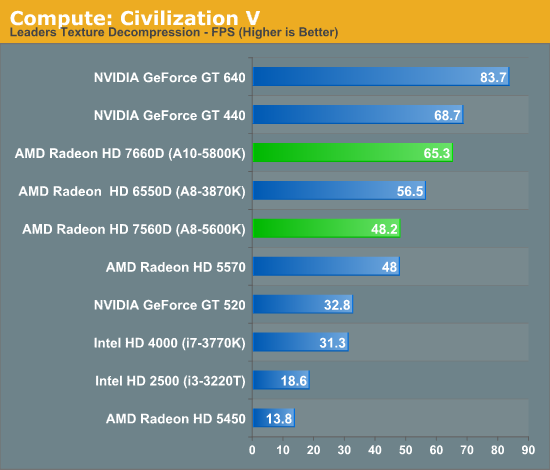
Similar to what we've already seen, Trinity offers a 15% increase in performance here compared to Llano. The compute advantage here over Intel's HD 4000 is solid as well.
Our next benchmark is SmallLuxGPU, the GPU ray tracing branch of the open source LuxRender renderer. We're now using a development build from the version 2.0 branch, and we've moved on to a more complex scene that hopefully will provide a greater challenge to our GPUs.
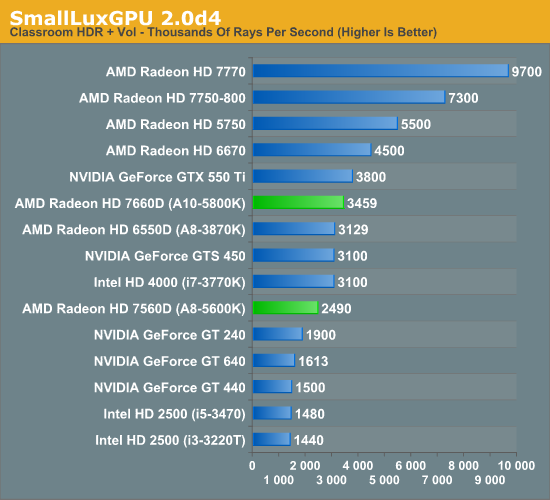
Intel significantly shrinks the gap between itself and Trinity in this test, and AMD doesn't really move performance forward that much compared to Llano either.
For our next benchmark we're looking at AESEncryptDecrypt, an OpenCL AES encryption routine that AES encrypts/decrypts an 8K x 8K pixel square image file. The results of this benchmark are the average time to encrypt the image over a number of iterations of the AES cypher. Note that this test fails on all Intel processor graphics, so the results below only include AMD APUs and discrete GPUs.
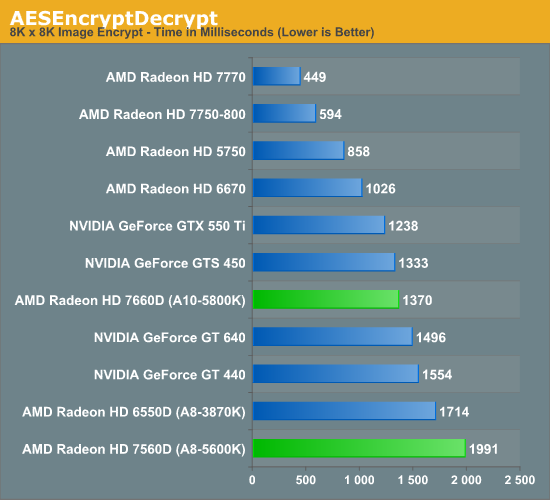
We see a pretty hefty increase in performance over Llano in our AES benchmark. The on-die Radeon HD 7660D even manages to outperform NVIDIA's GeForce GT 640, a $100+ discrete GPU.
Our fourth benchmark is once again looking at compute shader performance, this time through the Fluid simulation sample in the DirectX SDK. This program simulates the motion and interactions of a 16k particle fluid using a compute shader, with a choice of several different algorithms. In this case we're using an (O)n^2 nearest neighbor method that is optimized by using shared memory to cache data.
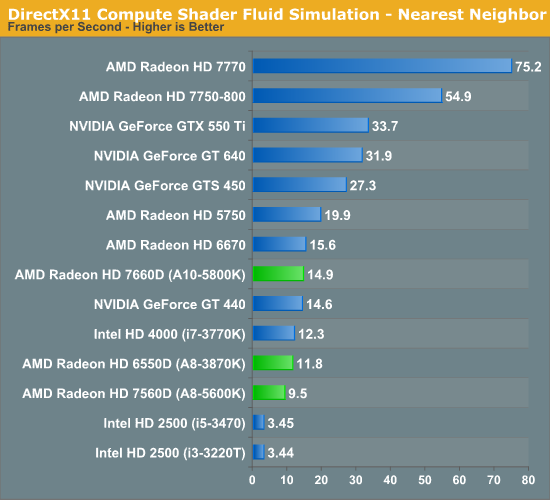
For our last compute test, Trinity does a reasonable job improving performance over Llano. If you're in need of a lot of GPU computing horsepower you're going to be best served by a discrete GPU, but it's good to see the processor based GPUs inch their way up the charts.
Synthetic Performance
Moving on, we'll take a few moments to look at synthetic performance. Synthetic performance is a poor tool to rank GPUs—what really matters is the games—but by breaking down workloads into discrete tasks it can sometimes tell us things that we don't see in games.
Our first synthetic test is 3DMark Vantage's pixel fill test. Typically this test is memory bandwidth bound as the nature of the test has the ROPs pushing as many pixels as possible with as little overhead as possible, which in turn shifts the bottleneck to memory bandwidth so long as there's enough ROP throughput in the first place.
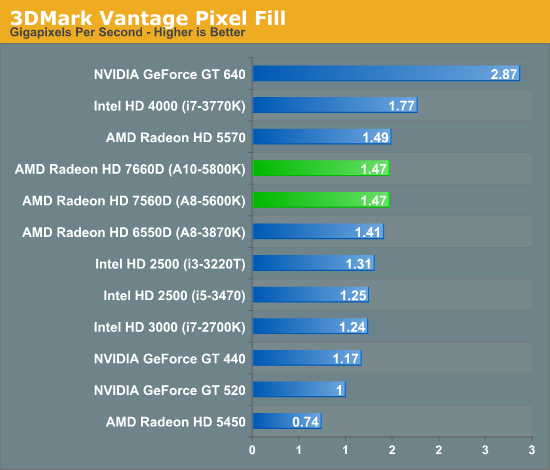
Since our Llano and Trinity numbers were both run at DDR3-1866, there's no real performance improvement here. Ivy Bridge actually does quite well in this test, at least the HD 4000.
Moving on, our second synthetic test is 3DMark Vantage's texture fill test, which provides a simple FP16 texture throughput test. FP16 textures are still fairly rare, but it's a good look at worst case scenario texturing performance.

Trinity is able to outperform Llano here by over 30%, although NVIDIA's GeForce GT 640 shows you what a $100+ discrete GPU can offer beyond processor graphics.
Our final synthetic test is the set of settings we use with Microsoft's Detail Tessellation sample program out of the DX11 SDK. Since IVB is the first Intel iGPU with tessellation capabilities, it will be interesting to see how well IVB does here, as IVB is going to be the de facto baseline for DX11+ games in the future. Ideally we want to have enough tessellation performance here so that tessellation can be used on a global level, allowing developers to efficiently simulate their worlds with fewer polygons while still using many polygons on the final render.
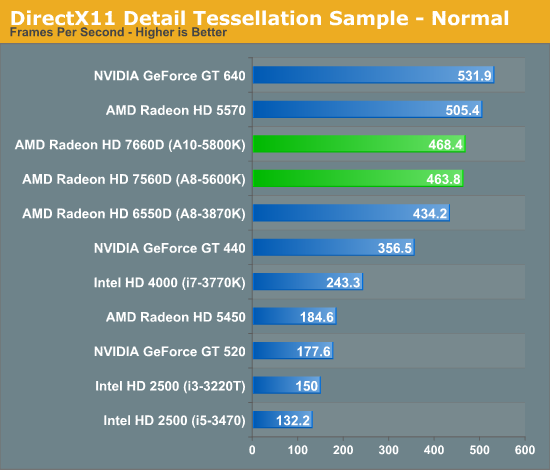
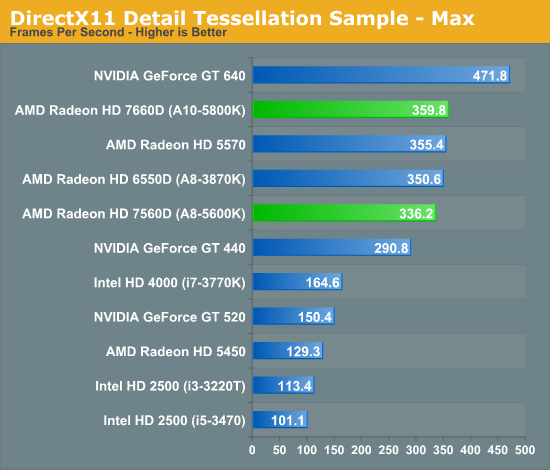
The tessellation results here were a bit surprising given the 8th gen tessellator in Trinity's GPU. AMD tells us it sees much larger gains internally (up to 2x), but using different test parameters. Trinity should be significantly faster than Llano when it comes to tessellation performance, depending on the workload that is.










139 Comments
View All Comments
kyuu - Friday, September 28, 2012 - link
"What I'm most looking forward to is a tablet of Surface quality with a low-voltage Trinity powering it."I should have said Trinity or, even better, one of its successors.
calzahe - Friday, September 28, 2012 - link
Memory is quite cheap now, you can find good DDR3 2133MHz 4GB 2x2GB modules for around 40usd for current 2 channel memory APUs, so you'll need to add just 40usd for another 4GB 2x2GB modules for the 4 channel memory APUs, but if done properly these APUs will be able to use 8GB of Memory. It means that for extra 40USD the new APU would be able to use 8GB of memory what is much more than 3-4GB in current monster video cards which cost 500-600usd. Also for around 100-150usd you can get DDR3 2133MHz 16GB 4x4GB.Can you imagine the level of next-gen graphics if APUs will be able to fully utilise 8GB, 16GB or even 32GB of 4 channel system memory!!!
Marburg U - Thursday, September 27, 2012 - link
So, Anand, you've just called this a "Review".Yes, you named it "part 1", but the fact is that at the moment you are publishing a review with only what AMD HAS TOLD YOU you are allowed to publish and which they are pleased to read.
How the hell can i trust this site's reviews anymore?
silverblue - Thursday, September 27, 2012 - link
You could always go to TechReport and join in the AMD bashing if you prefer. Whilst I don't completely agree with the idea of partially lifting the NDA in a specific fashion, it's clear that AMD wants to highlight the strengths of Trinity without possibly clouding the waters with middling x86 performance.Piledriver is not AMD's answer to Intel, even Vishera won't be an i7 competitor in most things and might struggle to stay with the i5s sometimes, and Zambezi was definitely underwhelming as a whole, so I can understand why they wouldn't want to focus on CPU performance. Additionally, if Vishera is due out at the same time as Trinity and you get an early idea of Trinity's CPU performance, even though Vishera will be generally faster than Trinity it may be classed at the same performance level.
cmdrdredd - Thursday, September 27, 2012 - link
What's clear is AMD cannot compete in benchmarks that matter to most people who read these sites(how fast does it transcode my video vs an i5). So they try to hide that behind GPU performance charts.It's like Apple misleading people about the performance of their CPUs back in the day.
silverblue - Thursday, September 27, 2012 - link
Amusingly, you'd think it would easily beat an i5 at transcoding... :PTaft12 - Sunday, September 30, 2012 - link
Uhh the benchmarks the readers of this site care about are the ones that ARE here - the gaming benchmarks. AT readers are intelligent enough to know CPUmark, Sandra, etc mean less than nothing.torp - Thursday, September 27, 2012 - link
The A10 65W looks like it has the same GPU and about 10% less CPU clock. Now THAT part could be really interesting for a low cost PC...rarson - Thursday, September 27, 2012 - link
Crossfire? Pairing one of these with a mid-range card in a hybrid Crossfire setup would be pretty awesome in an HTPC setup. Almost like a next-gen console, but much better.RU482 - Thursday, September 27, 2012 - link
looking to upgrade a couple of lower power SSF systems with one of those 65W CPUs. wonder how much an ITX mobo will run